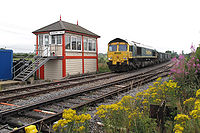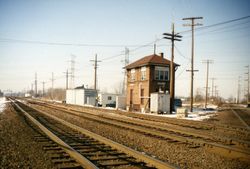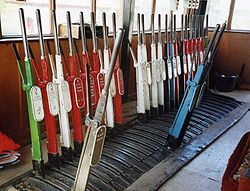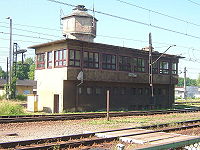
Signalling control
Encyclopedia

Rail transport
Rail transport is a means of conveyance of passengers and goods by way of wheeled vehicles running on rail tracks. In contrast to road transport, where vehicles merely run on a prepared surface, rail vehicles are also directionally guided by the tracks they run on...
system, signalling control is the process by which control is exercised over train movements by way of railway signal
Railway signal
A signal is a mechanical or electrical device erected beside a railway line to pass information relating to the state of the line ahead to train/engine drivers. The driver interprets the signal's indication and acts accordingly...
s and block systems to ensure that trains operate safely, over the correct route and to the proper timetable
Public transport timetable
A public transport timetable is a representation of public transport information to assist a passenger with planning a trip using public transport. A timetable details when vehicle will arrive and depart specified locations and may be organised for by route or for a particular stop...
. Signalling control was originally exercised via a decentralised network of control points that were known by a variety of names including signal box (British), interlocking tower (North America), signal poste (France) and signal cabin. Currently these decentralised systems are being consolidated into wide scale signalling centres or dispatch offices. Whatever the form, signalling control provides an interface between the human signal operator
Signalman (rail)
A signalman or signaller is an employee of a railway transport network who operates the points and signals from a signal box in order to control the movement of trains.- History :...
and the lineside signalling equipment
Railway signalling
Railway signalling is a system used to control railway traffic safely, essentially to prevent trains from colliding. Being guided by fixed rails, trains are uniquely susceptible to collision; furthermore, trains cannot stop quickly, and frequently operate at speeds that do not enable them to stop...
.
History

Machine
A machine manages power to accomplish a task, examples include, a mechanical system, a computing system, an electronic system, and a molecular machine. In common usage, the meaning is that of a device having parts that perform or assist in performing any type of work...
. Points and signals were operated locally from individual levers or handles, requiring the signalman to walk between the various pieces of equipment to set them in the required position for each train that passed. Before long, it was realised that control should be concentrated into one building, which came to be known as a signal box. The signal box provided a dry, climate controlled space for the complex interlocking
Interlocking
In railway signalling, an interlocking is an arrangement of signal apparatus that prevents conflicting movements through an arrangement of tracks such as junctions or crossings. The signalling appliances and tracks are sometimes collectively referred to as an interlocking plant...
mechanics and also the signalman. The raised design of most signal boxes (which gave rise to the term "tower" in North America) also provided the signalman with a good view of the railway under his control. The first use of a signal box was by the London and Croydon Railway
London and Croydon Railway
The London and Croydon Railway was an early railway which operated between London and Croydon in England. It was opened in 1839 and in July 1846 it merged with other railways to form a part of the London Brighton and South Coast Railway ....
in 1844 to control the branch line to Bricklayers' Arms
Bricklayers' Arms
Bricklayers' Arms is a busy road intersection between A2 and the London Inner Ring Road in south London, England. It is the junction of Tower Bridge Road, Old Kent Road, New Kent Road and Great Dover Street; Old Kent Road and New Kent Road east-bound are connected by a flyover.The area is named...
.
With the practical development of electric power, the complexity of a signal box was no longer limited by the distance a mechanical lever could work a set of points
Railroad switch
A railroad switch, turnout or [set of] points is a mechanical installation enabling railway trains to be guided from one track to another at a railway junction....
or a semaphore signal
Railway semaphore signal
One of the earliest forms of fixed railway signal is the semaphore. These signals display their different indications to train drivers by changing the angle of inclination of a pivoted 'arm'. Semaphore signals were patented in the early 1840s by Joseph James Stevens, and soon became the most...
via a direct physical connection (or the space required by such connections). Power operated switch points and signalling decides greatly expanded the territory that a single control point could operate from several hundred yards to several miles. As the technology of electric relay logic
Relay logic
Relay logic is a method of controlling industrial electronic circuits by using relays and contacts.-Ladder logic:The schematic diagrams for relay logic circuits are often called line diagrams, because the inputs and outputs are essentially drawn in a series of lines...
was developed, it no longer became necessary for signalmen to operate control devices
Lever frame
Mechanical railway signalling installations rely on lever frames for their operation to interlock the signals and points to allow the safe operation of trains in the area the signals control...
with any sort of mechanical logic at all. With the jump to all electronic logic, physical presence was no longer needed and the individual control points could be consolidated to increase system efficiency.
Another advancement made possible by the replacement of mechanical control by all electric systems was that the signalman's user interface could be enhanced to further improve productivity. The smaller size of electric toggles and push buttons put more functionality within reach of an individual signalman. Route-setting technology automated the setting of individual points and routes through busy junctions. Computerised video displays removed the physical interface all together, replacing it with a point-and-click
Point-and-click
Point-and-click is the action of a computer user moving a cursor to a certain location on a screen and then pressing a mouse button, usually the left button , or other pointing device...
or touchscreen
Touchscreen
A touchscreen is an electronic visual display that can detect the presence and location of a touch within the display area. The term generally refers to touching the display of the device with a finger or hand. Touchscreens can also sense other passive objects, such as a stylus...
interface. Finally, the use of Automatic Route Setting
Integrated Electronic control centre
The Integrated Electronic Control Centre was developed in the late 1980s by the British Rail Research Division for UK-based railway signalling centres, although variations exist around the world...
removed the need for any human input at all as common train movements could be fully automated according to a schedule or other scripted logic.
Signal boxes also served as important communications hubs, connecting the disparate parts of a rail line and linking them together to allow the safe passage of trains. The first signalling systems were made possible by technology like the telegraph and block instrument
British absolute block signalling
The principle of the British absolute block system of railway signalling is to ensure the safe operation of a railway by allowing only one train to occupy a defined section of track at a time...
that allowed adjacent signal boxes to communicate the status of a section of track. Later, the telephone put centralised dispatchers in contact with distant signal boxes and radio even allowed direct communication with the trains themselves. The ultimate ability for data to be transmitted over long distances has proven the demise of most local control signal boxes. Signalmen next to the track are no longer needed to serve as the eyes and ears of the signalling system. Track circuit
Track circuit
A track circuit is a simple electrical device used to detect the absence of a train on rail tracks, used to inform signallers and control relevant signals.- Principles and operation :...
s transmit train locations to distant control centres and data links allow direct manipulation of the points and signals.
While some rail systems have more signal boxes than others, most future signalling projects will result in increasing amounts of centralised control relegating the lineside signal box to niche or heritage applications.
Naming
In any nodeNode (networking)
In communication networks, a node is a connection point, either a redistribution point or a communication endpoint . The definition of a node depends on the network and protocol layer referred to...
-based control system, proper identification is critical to ensuring that messages are properly received by their intended recipients. As such, signalling control points are provided with names or identifiers that minimise the likelihood of confusion during communications.
In the United Kingdom and other Commonwealth countries, each signal box is assigned a unique name based on the geographical locality. Where multiple signal boxes existed at one locality, suffixes such as "West" and "East" were added to the geographical name, or they would be individually numbered, e.g. "Stockport No. 1", etc. In very remote areas, the name may be derived from the lineside mileage, e.g. "73rd Mile".
In Central Europe, it is common to issue signalling control points with a regionally unique location code based roughly on the point's location and function. The signalling locations may have longer, full names associated with them, but the identification codes can be employed more efficiently.
In North America, signalling locations were most often provided with one or two digit telegraph call letters
Call sign
In broadcasting and radio communications, a call sign is a unique designation for a transmitting station. In North America they are used as names for broadcasting stations...
that were locally unique to the rail line or division. These letters could stand for the control point's location or function as a form of mnemonic
Mnemonic
A mnemonic , or mnemonic device, is any learning technique that aids memory. To improve long term memory, mnemonic systems are used to make memorization easier. Commonly encountered mnemonics are often verbal, such as a very short poem or a special word used to help a person remember something,...
aid, but sometimes they were simply randomly or problematically chosen. The purpose of the short IDs were to reduce overhead when transmitting messages in Morse code
Morse code
Morse code is a method of transmitting textual information as a series of on-off tones, lights, or clicks that can be directly understood by a skilled listener or observer without special equipment...
. As time went on and voice communications replaced the Morse code the codes began to be replaced with more human recognizable names, again often based on geographic location. As control passed from field operators to centralised dispatchers, the dispatching desks took on identifiers that could encompass geographic areas or entire routes as well as simple numbers or programmatic identification codes.
In most cases where the control locations are still in the field adjacent to railway tracks, the name or code of the control point is plainly labelled on the side of the signal box structure as an extra visual reminder to the train operators where they are. Moreover, wayside signals may also be equipped with identification plates that directly or indirectly indicate who controls that signal and that stretch of the line.
Lever frame

Interlocking
In railway signalling, an interlocking is an arrangement of signal apparatus that prevents conflicting movements through an arrangement of tracks such as junctions or crossings. The signalling appliances and tracks are sometimes collectively referred to as an interlocking plant...
was attached to the levers, which ensured that signals showed the correct indication with regard to the points and were operated in the right order. Wires or rods, connected at one end to the signals and points and at the other to levers in the signal box, ran alongside the railway.
In many countries, levers are painted according to their function, e.g. red for stop signals and black for points, and are usually numbered, from left to right, for identification. In most cases, a diagram of the track and signalling layout is mounted above the lever frame, showing the relevant lever numbers adjacent to the signals and points.
Handpowered interlockings were referred to as armstrongs and handthrows in the United States.
Power frames have miniature levers and control the signals and points electrically. In some cases, the interlocking was still done mechanically, but in others, electric lever locks were used.
In a few cases, signals and points were operated pneumatically upon operation of the appropriate lever or slide.
Control panel
In a signal box with a control panel, the levers are replaced by buttons or switches, usually appropriately positioned directly onto the track diagram. These buttons or switches are interfaced with an electrical or electronic interlocking. In the UK, control panels are of the following types:Individual Function Switch (IFS)
- A separate button/switch is provided for each signal and for each set of points. This type of panel is operated in a similar manner to a lever frame. The signalman must move each set of points to the desired position before operating the switch or button of the signal reading over them.
- This type of panel needs the least complex circuitry but is not suited to controlling large or busy areas.
One Control Switch (OCS)
- A separate switch/button is provided for every signalled route. There will be as many switches/buttons per signal as there are routes (i.e. signalled destinations) from that signal. To set the desired route, the relevant switch or button is operated. All points within the route are automatically set to the required position.
- Individual points switches are provided, but they are normally left in the central position, which allows the points to be automatically set by the action of setting a route.
Entrance-Exit (NX)
- This type of panel has one switch/button provided for every signalled route (except that some panels have separate 'entrance' and 'exit' devices). To set a route, the signalman operates the device for the 'entrance' signal, followed by the device for the 'exit' (destination) signal. All points within the route are automatically set to the required position and, provided all the points are detected by the interlocking in the correct position the signal will clear.
- Individual points switches are provided, but they are normally left in the central position, which allows the points to be automatically set to the normal or reverse position by the action of setting a route.
Similar principles of operation as described above are applicable throughout the world.
Visual Display Unit
Modern signal boxes nowadays tend to be provided with VDUComputer display
A monitor or display is an electronic visual display for computers. The monitor comprises the display device, circuitry, and an enclosure...
based, or similar, control systems. These systems are less expensive to build and easier to alter than a traditional panel. In the UK, large modern signal boxes are typically of the Integrated Electronic Control Centre
Integrated Electronic control centre
The Integrated Electronic Control Centre was developed in the late 1980s by the British Rail Research Division for UK-based railway signalling centres, although variations exist around the world...
type. Variations of these control systems are used throughout the world.
Present day

Heritage railway
thumb|right|the Historical [[Khyber train safari|Khyber Railway]] goes through the [[Khyber Pass]], [[Pakistan]]A heritage railway , preserved railway , tourist railway , or tourist railroad is a railway that is run as a tourist attraction, in some cases by volunteers, and...
s.
The modern control centre has largely replaced widespread signal cabins. These centres, usually located near main railway stations
Train station
A train station, also called a railroad station or railway station and often shortened to just station,"Station" is commonly understood to mean "train station" unless otherwise qualified. This is evident from dictionary entries e.g...
, control the track network using electrical or electronic systems. One such system is CTC
Centralized traffic control
Centralized traffic control is a form of railway signalling that originated in North America and centralizes train routing decisions that were previously carried out by local signal operators or the train crews themselves. The system consists of a centralized train dispatcher's office that...
, Centralised Traffic Control.

